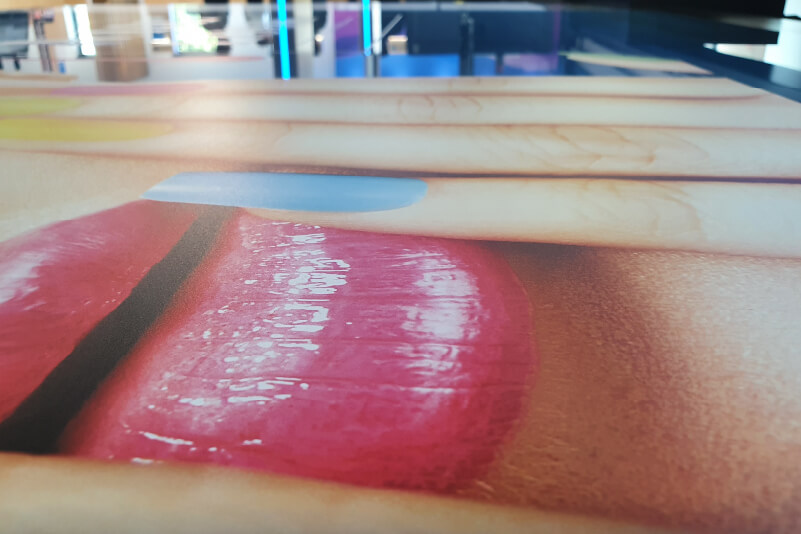When you start out with digital printing, the foundational ink you use will be CMYK. This works great for printing onto white surfaces like adhesive vinyl or banner material. As your business grows, it won’t be long until a customer asks you for some window graphics.
Using this system, you can also print onto transparent window films, but you’ll notice that the output isn’t the same. Since CMYK solvent or UV ink is semi-transparent, there will be an evident loss in vibrancy when it’s applied to a transparent material. This is where white ink comes in handy.

Printing on Transparent Substrates
As we have seen, fully vibrant colours cannot be achieved on a transparent material using CMYK ink alone. It’s possible to cut shapes from white vinyl and apply them to the relevant areas, but this is a tricky and time-consuming job.
By using a device which includes a white ink channel, you can print these white areas accurately and just as easily as printing any other colour. To do this, you simply need to specify a spot colour in your design file. The RIP will recognise this and interpret it as white ink which needs to be printed.
Depending on the application, you may wish to print the white ink first as a base for your CMYK layer. Alternatively, you can print the CMYK data first, then cover it with a layer of white ink – this process in normally used when printing UV ink onto acrylic photo blocks where the photo is on the rear side of the substrate.
Varying Opacity in the Design
Aside from the faster, more accurate workflow, there is another key reason to use white ink instead of a separate white vinyl mask. Including the white areas as print data gives you much more flexibility when it comes to designing the final product.
For example, if you are printing graphics for a shop window, you might not want to block visibility completely across the entire artwork – perhaps you only need to highlight the text elements of the graphic. In this case, you can be very specific about the areas which should be backed with white ink and which areas should have a semi-transparent effect.
This ensures that the text is clearly visible and stands out from the rest of the design, and that the other elements can be seen without completely obscuring the view of the products inside the store.
This method can also be used forpackaging prototyping where specialist substrates such as metallic cards can be partially masked to create an impactful design that balances metallic and solid colour elements.

Printing on Dark Surfaces
You may also need to print onto dark or coloured substrates for various applications. In this case, printing a vinyl decal might work well, but this extends the production time and reduces the margin for error. Printing direct to the substrate is not only faster and more reliable, but it also produces a neater, more professional result.
As the CMYK ink is semi-transparent, printing direct to a dark or coloured material will result in a blended colour with the shade of the substrate showing through. Using white ink, you can create a white surface underneath your CMYK ink ensuring that the image appears as desired without being obscured.
This is also useful when printing directly to solid objects in the case of UV printing. Whether you need to print small promotional items like USB sticks or larger items like electronics casings, you can never guarantee that the item will be white in colour. For applications like these, white ink is essential to ensure you can satisfy any customer order. White DTG (direct-to-garment) ink is also used for printing on dark garments for the same reason.
Important Things to Know About White Ink
To achieve its unique properties, white ink is formulated differently from CMYK ink. It usually contains microscopic particles in suspension which allow an opaque finish. For this reason, any device which includes white ink also includes a system which agitates or circulates the ink. This keeps the ink at a consistent density and prevents settling or clogging.
When choosing a device that can print white ink, one of the most important things to consider is the white ink’s opacity. You may be tempted to opt for a cheaper system with less-opaque ink, but this will cost more in the long run. This is because it will require several passes of white ink to achieve the desired opacity meaning you use more ink, and it takes longer to produce your graphics.
High-opacity ink lets you produce a solid block of white in a single pass without negatively impacting your workflow.
Conclusion
Many print businesses do just fine without ever needing to use white ink. If you wish to give your customers more options and be more flexible with the kinds of products you offer, high-opacity white ink can make a big difference to your reputation as a seller and ultimately help you generate more profits for your business.
If you’d like to know more about white ink printing options, get in touch with us and speak to an expert about where you’d like your business to go.

